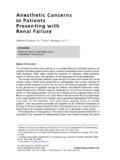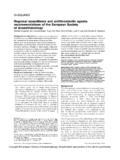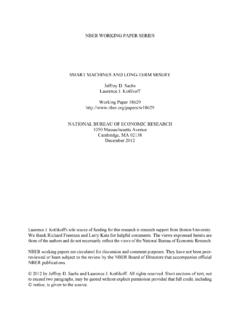Transcription of Coagulation in pregnancy - CSEN
1 7 Coagulation in pregnancyPatrick Thornton, BMSc, MBBCh, FCARCSI, Clinical Research Fellow,Joanne douglas , MD, FRCPC, Clinical Professor*Department of Anesthesia, University of British Columbia, BC Women s Hospital, Vancouver, BC, CanadaKeywords:coagulationhaemostasisfib rinolysisplateletsthrombocytopaeniacoagu lation factorsfactor deficienciespregnancyheparinthrombophili aneuraxial anaesthesianeuraxial haematomaThe Coagulation system undergoes significant change duringpregnancy. The clinician caring for the parturient must understandthese changes, particularly when the parturient has a pre-existinghaematological condition. Because many haematological condi-tions are rare, there often is limited information to guide theobstetric and anaesthetic management of these parturients. 2009 Elsevier Ltd. All rights limit blood loss after trauma it is essential to seal bleeding vessels without affecting blood flowpermanently.
2 Haemostasis, defined as the arrest of bleeding, comes from the Greek roots,haememeaning blood andstasismeaning causing to stop. The process of haemostasis is a dynamic anddelicate equilibrium between Coagulation and fibrinolysis (Fig. 1). Coagulation results from an inter-action among vessel walls, platelets and Coagulation endothelial damage, plateletsadhere to the subendothelium forming a platelet plug which then becomes permanent with formation is limited by antithrombin (AT) and proteins C and S. The fibrinolyticsystem functions to maintain the fluid state through the breakdown of fibrin by plasmin. Plasmin isgenerated from plasminogen by the action of tissue plasminogen activator (t-PA).Physiological changes to Coagulation during pregnancyPregnancy is associated with changes in haemostasis, including an increase in the majority ofclotting factors, a decrease in the quantity of natural anticoagulants and a reduction in fibrinolytic*Corresponding author.
3 Department of Anesthesia, BC Women s Hospital, Room 1Q72, 4500 Oak Street, V6H 3N1 Vancouver,BC, Canada. Tel.: 1 604 875 2158; Fax: 1 604 875 douglas ).Contents lists available atScienceDirectBest Practice & Research ClinicalObstetrics and Gynaecologyjournal homepage: $ see front matter 2009 Elsevier Ltd. All rights Practice & Research Clinical Obstetrics and Gynaecology 24 (2010) 339 4 These changes result in a state of hypercoagulability,2,4are likely due to hormonal changes5and increase the risk of increase in clotting activity is greatest at the time of delivery with placental expulsion, releasingthromboplastic substances stimulate clot formation to stop maternal blood loss. Asplacental blood flow is up to 700 ml min 1, considerable haemorrhage can occur if clotting and fibrinolysis generally return to pre-pregnant levels 3 4 weeks ,3a.
4 PlateletsThe platelet count decreases in normal pregnancy possibly due to increased destruction and hae-modilution with a maximal decrease in the third Coagulation factorsFactors VIII (FVIII), von Willebrand factor (vWf), ristocetin cofactor (RCoA) and factors X (FX) and XII(FXII) increase during ,4 Levels of factor VII (FVII) increase gradually during pregnancy andreach very high levels (up to 1000%) by ,7 Fibrinogen also increases during pregnancy with levelsat term 200% above pre-pregnant SYSTEML arge FragmentsFibrin degradation productsSmall fragmentsDouble chainurokinaseKallikreinFibrinSingle chainurokinasePlasminProurokinasePlasmin ogen activatorFibrinPlasminogenX XaX Ca++VaPF3 Prothrombin (II) Thrombin (IIa)COMMON PATHWAYCa++Fibrinogen (I)Fibrin monomerSoluble fibrin polymerCa++XIIIaInsoluble polymerEXTRINSICVIICa++VIIaLipidThrombop lastinCa++INTRINSICC ollagenKallikreinPrekallikreinXIIXIIa + KininogenXIaXIIX Ca++IXaInhibitionInhibitionFig.
5 Coagulation Thornton, J. douglas / Best Practice & Research Clinical Obstetrics and Gynaecology 24 (2010) 339 352340 Other factors either remain at non-pregnant levels or decrease during pregnancy . Factor XIII (FXIII),which is responsible for stabilising fibrin, increases in the first trimester but by term it is 50% of non-pregnant V (FV) concentrations increase in early pregnancy then decrease and II (FII, prothrombin) levels may increase or not change in early pregnancy but are normal is debate about factor XI (FXI) levels with reports indicating increases or ,10 Similarly, FIX levels are reported as increasing, decreasing or remaining stable throughout one study, 50% of carriers of FIX deficiency had FIX levels 50 IU dl 1at C levels remain the same or are slightly increased during pregnancy12while protein Sdecreases.
6 AT levels remain normal during ,4c. FibrinolysisFibrinolysis is reduced in pregnancy due to decreases in t-PA activity, which remains low until 1-hpostpartumwhen activity returns to reduction is due to the gradual, eventually threefold,increase in plasminogen activator inhibitor-1 (PAI-1) and the increasing levels of plasminogen activatorinhibitor-2 (PAI-2).4 The placenta produces PAI-1 and is the primary source of PAI-2. PAI-2 levels atterm are 25 times that of normal , t-PA levels quickly return to normal as PA-1levels decrease; however, PA-2 levels remain elevated for a few fibrinolysis inhibitor (TAFI) (an antifibrinolytic which cleaves the C-terminallysine in fibrin to render it resistant to cleavage by plasmin) levels are increased in the third levels increase in pregnancy15,16but are not thought to indicate intravascular Coagulation asfibrinolysis is depressed.
7 These D-Dimers may originate from the of coagulationObstetric anaesthetists are concerned that providing neuraxial anaesthesia in parturients withcoagulation abnormalities may cause bleeding in the epidural or subarachnoid space with neurologicalimpairment (spinal/epidural/neuraxial haematoma). Neuraxial haematomas associated with neuraxialblocks have been reported rarely in the non-pregnant population, spinal haematomasassociated with neuraxial blocks often occur in patients with an underlying coagulopathy. Ideally, therewould be a test that would predict the risk of bleeding in the epidural/spinal Platelet countSome anaesthetists rely on platelet count as a screening test for Coagulation abnormalities inhealthy parturients prior to neuraxial block. However, the American Society of AnesthesiologistsPractice Guidelines for Obstetric Anesthesia states that a platelet count is not essential prior to neu-raxial block in a healthy parturient with no risk factors for there are some rareconditions that result in abnormal platelet function ( , May Hegglin anomaly) a normal plateletcount will provide reassurance that Coagulation is normal in a healthy parturient.
8 A platelet count atterm<70 109l 1may indicate the presence of HELLP (haemolysis, elevated liver enzymes, lowplatelets) syndrome, disseminated intravascular Coagulation (DIC), immune thrombocytopaenia andother rare conditions co-existing with pregnancy . Questions have been raised about platelet function inpre-eclampsia,20,21but as these studies used bleeding time, their results are not considered , the concern remains and is not yet Prothrombin timeAs most Coagulation factors increase in normal pregnancy , the prothrombin time (PT) and theactivated partial thromboplastin time (APTT) are shortened. The PT and its derived measure, inter-national normalised ratio (INR), test for factors such as FII, FV, FVII, FX and fibrinogen. Some nutritionaldeficiencies and/or liver disease will decrease these factors prolonging the PT. Furthermore, PT andP.
9 Thornton, J. douglas / Best Practice & Research Clinical Obstetrics and Gynaecology 24 (2010) 339 352341 APTT may be artificially prolonged due to the presence of an antiphospholipid antibody (APLA), such aslupus anticoagulant. In fact, patients with APLA are Activated partial thromboplastin timeThe APTT is considered a good screening test for deficiencies of FVIII, FIX, FXI and FXII. The APTT maybe prolonged by the presence of an APLA and/or unfractionated/standard heparin (SH). To differentiatebetween the presence of an APLA and a factor deficiency, the patient s plasma is mixed 50:50 withnormal plasma. If the APTT remains abnormal an APLA is Bleeding timeSince its introduction, bleeding time was used to assess platelet function in parturients withthrombocytopaenia. A prolonged bleeding time was thought to predict the risk of bleeding, whichtheoretically could increase the risk of a neuraxial haematoma.
10 However, bleeding time is used rarelynow as it has a number of disadvantages: it is invasive, unreliable, highly operator dependent and notsuitable to repeated tests. Bleeding time also is insensitive, especially to mild platelet defects, and nota good predictor of bleeding ,23 Because of these problems, other tests are being Thrombo-elastographyThe thromboelastograph (TEG) provides information about the various stages of Coagulation andfibrinolysis. The maximum amplitude (MA) is thought to represent platelet function. TEG is used bysome centres to predict the risk of bleeding from Coagulation abnormalities; however, the sensitivityand specificity of TEG in pregnancy remain ,25An abnormal test has not been shown to bepredictive for development of a neuraxial haematoma, but most anaesthetists will not provide regionalanaesthesia if the MA is Platelet function analyser (PFA)This test measures the speed of formation of a platelet plugin vitro, expressed as closure time inseconds.
















